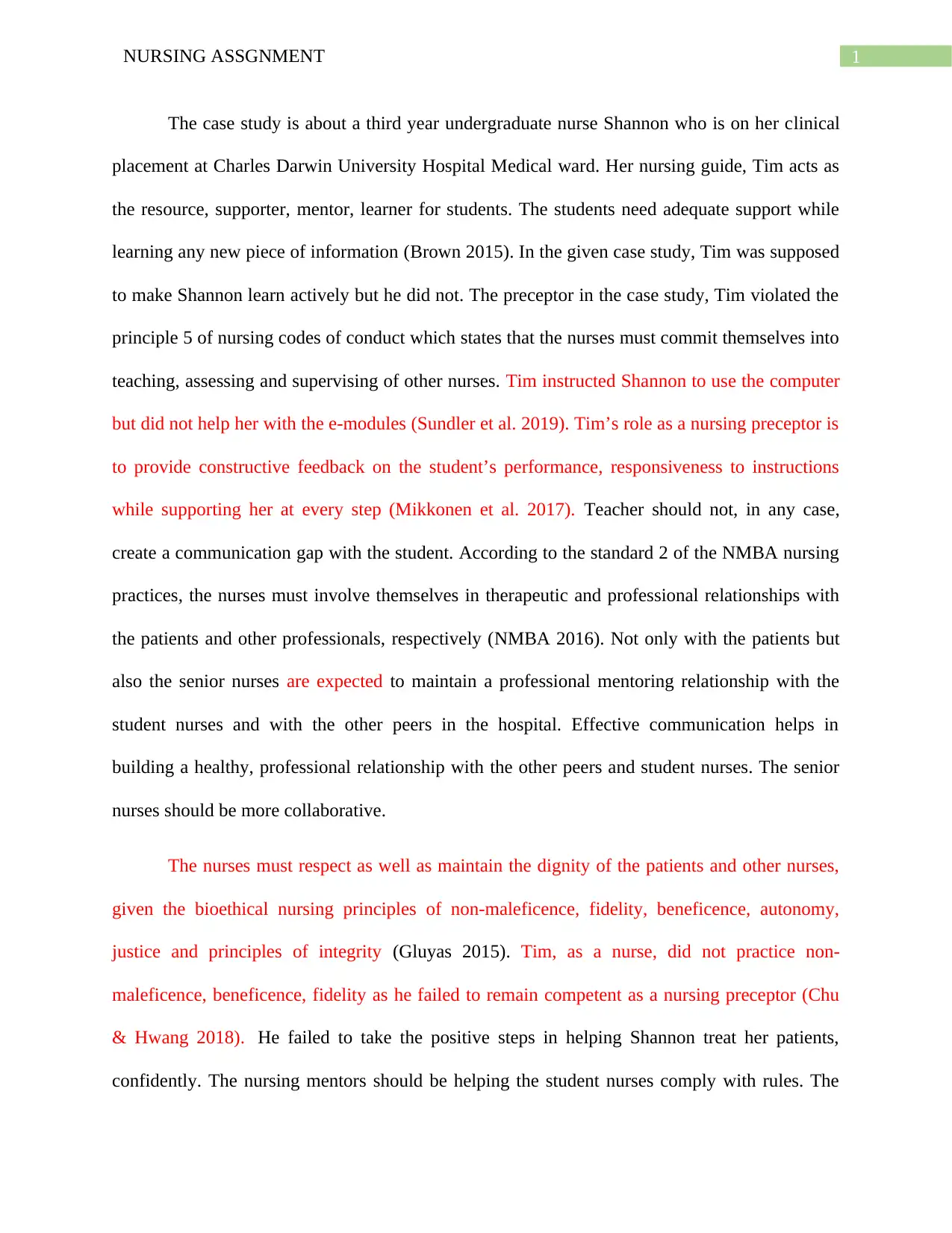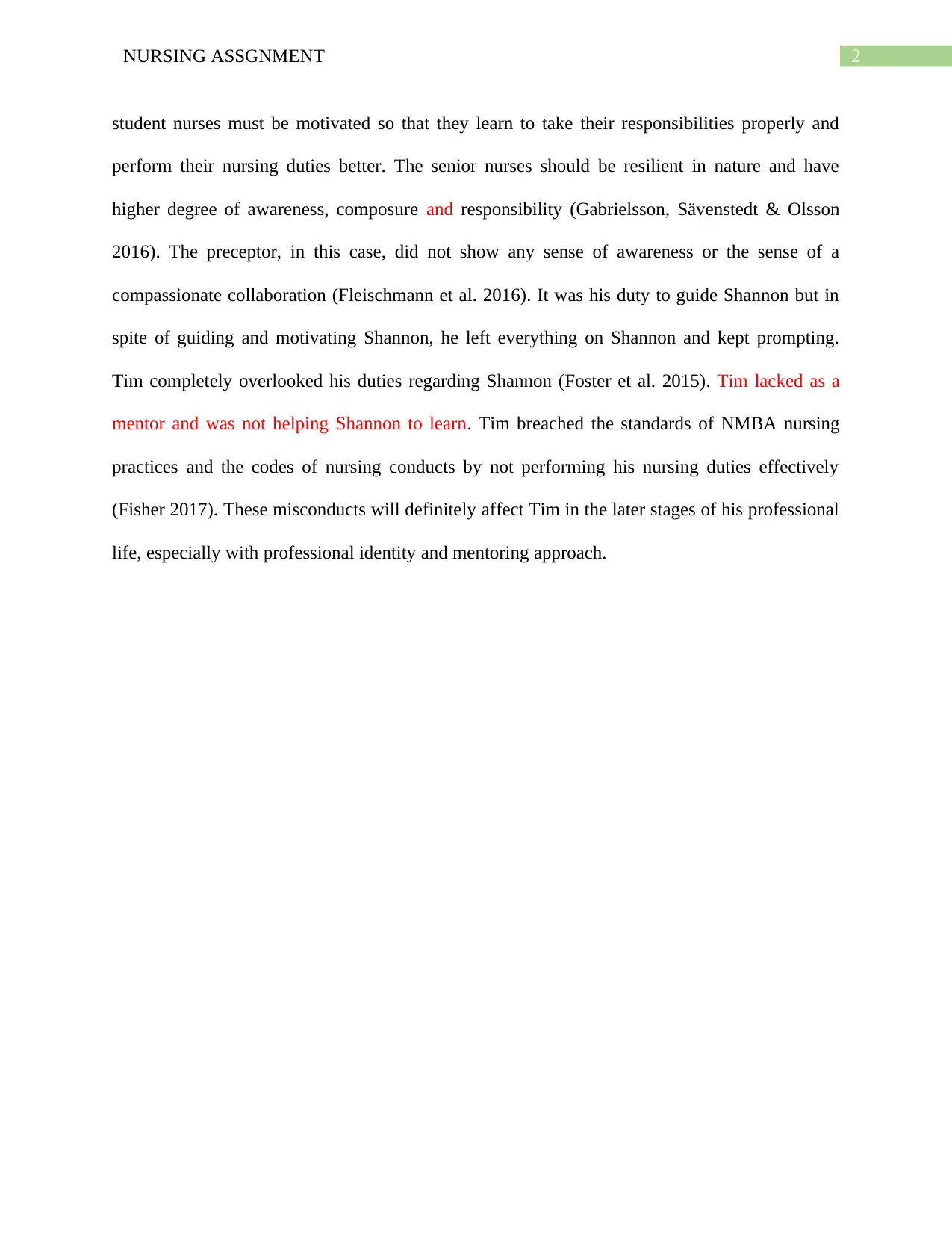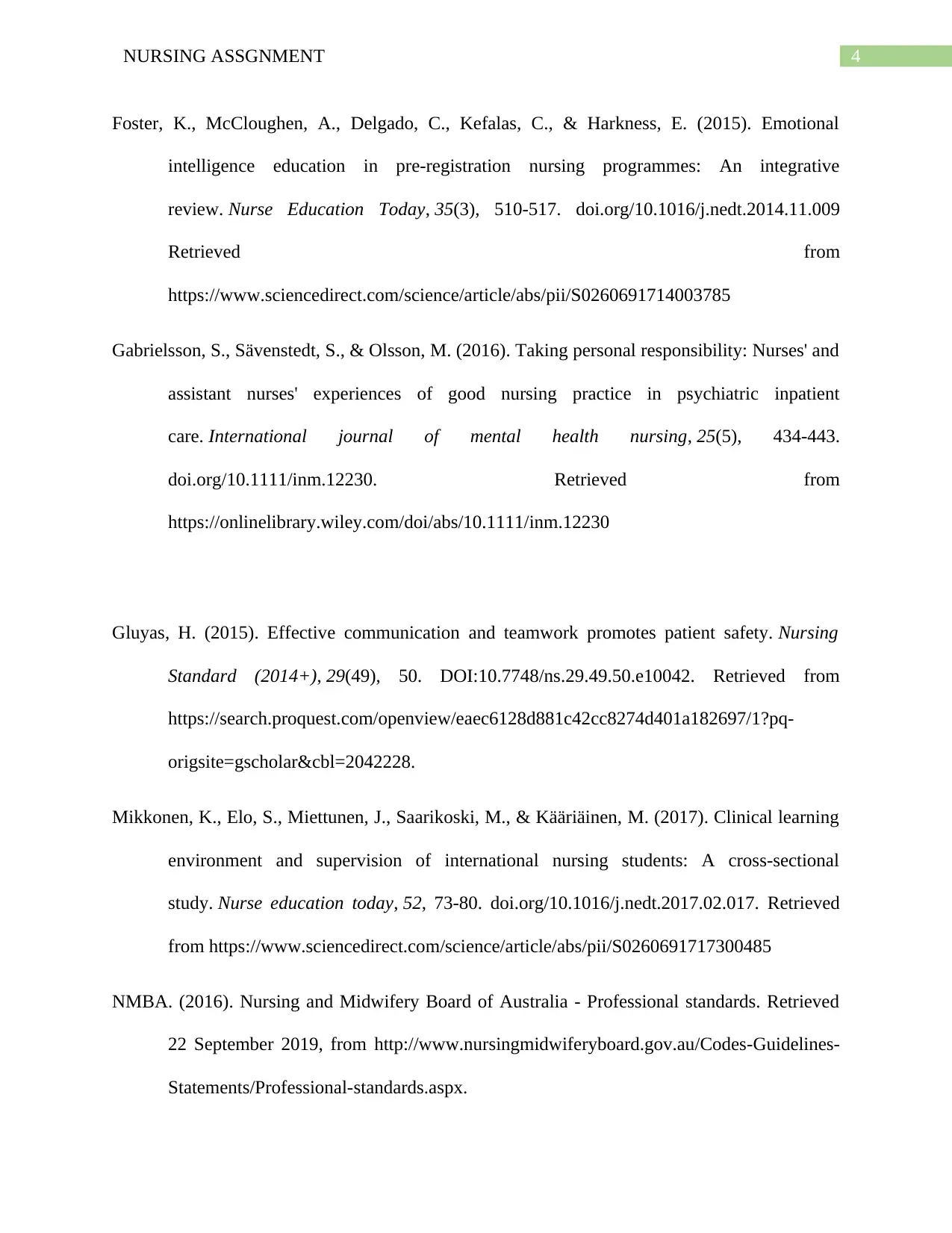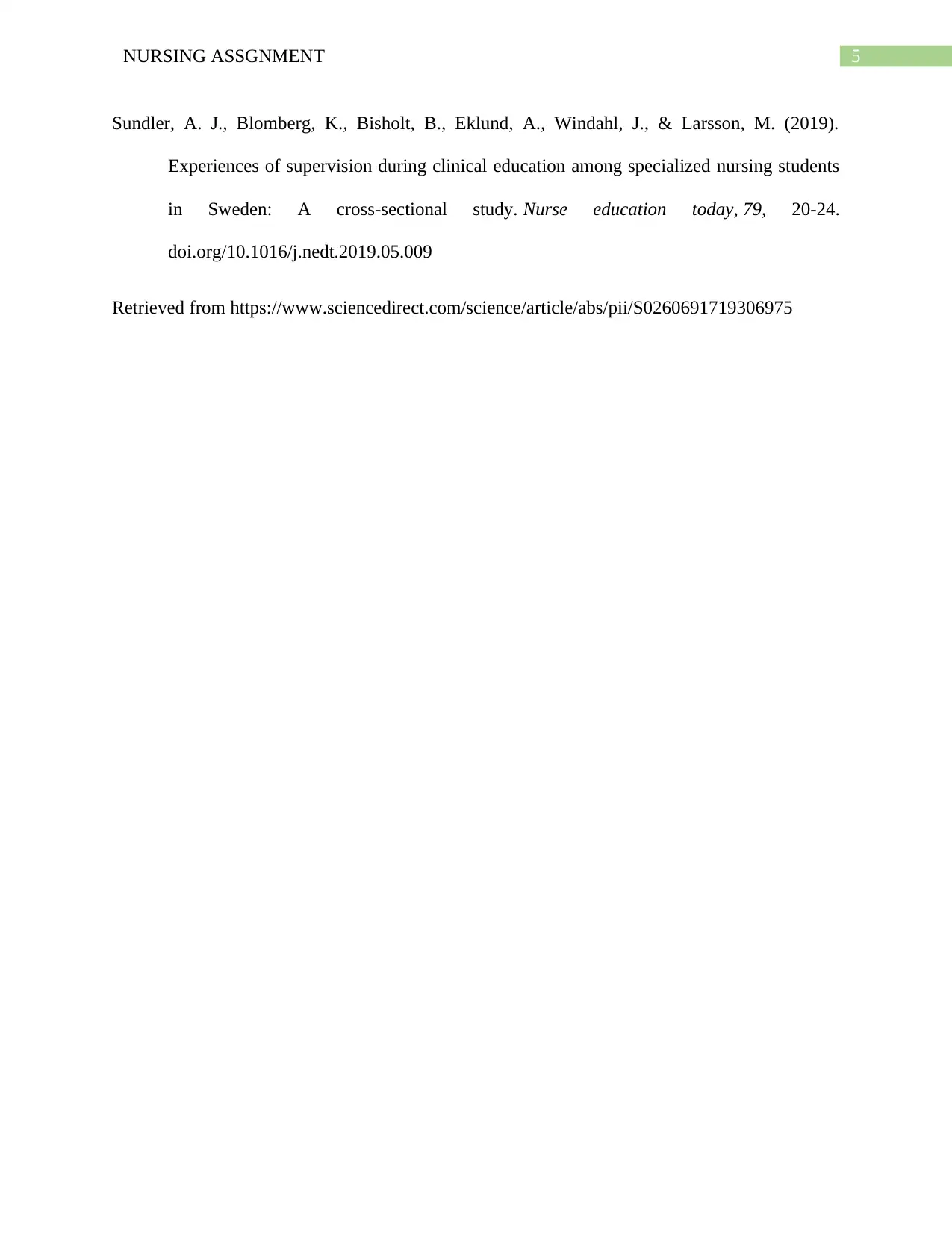Charles Darwin University: Nursing Case Study on Preceptor's Role
VerifiedAdded on 2022/10/31
|6
|1094
|319
Case Study
AI Summary
This case study examines a scenario involving Shannon, a third-year undergraduate nursing student at Charles Darwin University Hospital, and her preceptor, Tim. The assignment highlights the importance of effective mentorship and adherence to the Nursing and Midwifery Board of Australia (NMBA) standards during clinical placements. Tim's failure to actively support Shannon, guide her learning, and provide constructive feedback is analyzed, emphasizing violations of the nursing code of conduct, particularly regarding teaching and supervision. The case study references several research papers to support its claims and discusses the impact of the preceptor's actions on Shannon's professional development, including issues related to communication, professional relationships, and the application of bioethical principles. The preceptor's lack of awareness and compassionate collaboration is criticized, as it failed to motivate and guide the student, ultimately breaching the standards of nursing practices.

Running head: NURSING ASSIGNMENT
NURSING ASSIGNMENT
Name of the Student
Name of the University
Author note
NURSING ASSIGNMENT
Name of the Student
Name of the University
Author note
Paraphrase This Document
Need a fresh take? Get an instant paraphrase of this document with our AI Paraphraser

1NURSING ASSGNMENT
The case study is about a third year undergraduate nurse Shannon who is on her clinical
placement at Charles Darwin University Hospital Medical ward. Her nursing guide, Tim acts as
the resource, supporter, mentor, learner for students. The students need adequate support while
learning any new piece of information (Brown 2015). In the given case study, Tim was supposed
to make Shannon learn actively but he did not. The preceptor in the case study, Tim violated the
principle 5 of nursing codes of conduct which states that the nurses must commit themselves into
teaching, assessing and supervising of other nurses. Tim instructed Shannon to use the computer
but did not help her with the e-modules (Sundler et al. 2019). Tim’s role as a nursing preceptor is
to provide constructive feedback on the student’s performance, responsiveness to instructions
while supporting her at every step (Mikkonen et al. 2017). Teacher should not, in any case,
create a communication gap with the student. According to the standard 2 of the NMBA nursing
practices, the nurses must involve themselves in therapeutic and professional relationships with
the patients and other professionals, respectively (NMBA 2016). Not only with the patients but
also the senior nurses are expected to maintain a professional mentoring relationship with the
student nurses and with the other peers in the hospital. Effective communication helps in
building a healthy, professional relationship with the other peers and student nurses. The senior
nurses should be more collaborative.
The nurses must respect as well as maintain the dignity of the patients and other nurses,
given the bioethical nursing principles of non-maleficence, fidelity, beneficence, autonomy,
justice and principles of integrity (Gluyas 2015). Tim, as a nurse, did not practice non-
maleficence, beneficence, fidelity as he failed to remain competent as a nursing preceptor (Chu
& Hwang 2018). He failed to take the positive steps in helping Shannon treat her patients,
confidently. The nursing mentors should be helping the student nurses comply with rules. The
The case study is about a third year undergraduate nurse Shannon who is on her clinical
placement at Charles Darwin University Hospital Medical ward. Her nursing guide, Tim acts as
the resource, supporter, mentor, learner for students. The students need adequate support while
learning any new piece of information (Brown 2015). In the given case study, Tim was supposed
to make Shannon learn actively but he did not. The preceptor in the case study, Tim violated the
principle 5 of nursing codes of conduct which states that the nurses must commit themselves into
teaching, assessing and supervising of other nurses. Tim instructed Shannon to use the computer
but did not help her with the e-modules (Sundler et al. 2019). Tim’s role as a nursing preceptor is
to provide constructive feedback on the student’s performance, responsiveness to instructions
while supporting her at every step (Mikkonen et al. 2017). Teacher should not, in any case,
create a communication gap with the student. According to the standard 2 of the NMBA nursing
practices, the nurses must involve themselves in therapeutic and professional relationships with
the patients and other professionals, respectively (NMBA 2016). Not only with the patients but
also the senior nurses are expected to maintain a professional mentoring relationship with the
student nurses and with the other peers in the hospital. Effective communication helps in
building a healthy, professional relationship with the other peers and student nurses. The senior
nurses should be more collaborative.
The nurses must respect as well as maintain the dignity of the patients and other nurses,
given the bioethical nursing principles of non-maleficence, fidelity, beneficence, autonomy,
justice and principles of integrity (Gluyas 2015). Tim, as a nurse, did not practice non-
maleficence, beneficence, fidelity as he failed to remain competent as a nursing preceptor (Chu
& Hwang 2018). He failed to take the positive steps in helping Shannon treat her patients,
confidently. The nursing mentors should be helping the student nurses comply with rules. The

2NURSING ASSGNMENT
student nurses must be motivated so that they learn to take their responsibilities properly and
perform their nursing duties better. The senior nurses should be resilient in nature and have
higher degree of awareness, composure and responsibility (Gabrielsson, Sävenstedt & Olsson
2016). The preceptor, in this case, did not show any sense of awareness or the sense of a
compassionate collaboration (Fleischmann et al. 2016). It was his duty to guide Shannon but in
spite of guiding and motivating Shannon, he left everything on Shannon and kept prompting.
Tim completely overlooked his duties regarding Shannon (Foster et al. 2015). Tim lacked as a
mentor and was not helping Shannon to learn. Tim breached the standards of NMBA nursing
practices and the codes of nursing conducts by not performing his nursing duties effectively
(Fisher 2017). These misconducts will definitely affect Tim in the later stages of his professional
life, especially with professional identity and mentoring approach.
student nurses must be motivated so that they learn to take their responsibilities properly and
perform their nursing duties better. The senior nurses should be resilient in nature and have
higher degree of awareness, composure and responsibility (Gabrielsson, Sävenstedt & Olsson
2016). The preceptor, in this case, did not show any sense of awareness or the sense of a
compassionate collaboration (Fleischmann et al. 2016). It was his duty to guide Shannon but in
spite of guiding and motivating Shannon, he left everything on Shannon and kept prompting.
Tim completely overlooked his duties regarding Shannon (Foster et al. 2015). Tim lacked as a
mentor and was not helping Shannon to learn. Tim breached the standards of NMBA nursing
practices and the codes of nursing conducts by not performing his nursing duties effectively
(Fisher 2017). These misconducts will definitely affect Tim in the later stages of his professional
life, especially with professional identity and mentoring approach.
⊘ This is a preview!⊘
Do you want full access?
Subscribe today to unlock all pages.

Trusted by 1+ million students worldwide

3NURSING ASSGNMENT
References
Brown, A. M. (2015). Simulation in undergraduate mental health nursing education: A literature
review. Clinical Simulation in Nursing, 11(10), 445-449.
doi.org/10.1016/j.ecns.2015.08.003 Retrieved from
http://sci-hub.tw/10.1016/j.ecns.2015.08.003
Chu, M. S., & Hwang, Y. Y. (2018). Subjectivity about Bioethics among Nursing Students with
Experience Volunteering in Elderly Care Facilities. J Korean Acad Soc Nurs Educ, 24(1),
50. doi.org/10.5977/jkasne.2018.24.1.50 Retrieved from
https://www.koreamed.org/article/0218JKASNE/2018.24.1.50
Fisher, M. (2017). Professional standards for nursing practice: How do they shape contemporary
rehabilitation nursing practice?. Journal of the Australasian Rehabilitation Nurses
Association, 20(1),4.https://search.informit.com.au/documentSummary;dn=08430695297
8817;res=IELHEA;type=pdf Retrieved from
https://search.informit.com.au/documentSummary;dn=084306952978817;res=IELHEA;t
ype=pdf
Fleischmann, N., Tetzlaff, B., Werle, J., Geister, C., Scherer, M., Weyerer, S., ... & Mueller, C.
A. (2016). Interprofessional collaboration in nursing homes (interprof): a grounded
theory study of general practitioner experiences and strategies to perform nursing home
visits. BMC family practice, 17(1), 123. doi.org/10.1186/s12875-016-0522-z Retrieved
from the
https://search.informit.com.au/documentSummary;dn=084306952978817;res=IELHEA;t
ype=pdf
References
Brown, A. M. (2015). Simulation in undergraduate mental health nursing education: A literature
review. Clinical Simulation in Nursing, 11(10), 445-449.
doi.org/10.1016/j.ecns.2015.08.003 Retrieved from
http://sci-hub.tw/10.1016/j.ecns.2015.08.003
Chu, M. S., & Hwang, Y. Y. (2018). Subjectivity about Bioethics among Nursing Students with
Experience Volunteering in Elderly Care Facilities. J Korean Acad Soc Nurs Educ, 24(1),
50. doi.org/10.5977/jkasne.2018.24.1.50 Retrieved from
https://www.koreamed.org/article/0218JKASNE/2018.24.1.50
Fisher, M. (2017). Professional standards for nursing practice: How do they shape contemporary
rehabilitation nursing practice?. Journal of the Australasian Rehabilitation Nurses
Association, 20(1),4.https://search.informit.com.au/documentSummary;dn=08430695297
8817;res=IELHEA;type=pdf Retrieved from
https://search.informit.com.au/documentSummary;dn=084306952978817;res=IELHEA;t
ype=pdf
Fleischmann, N., Tetzlaff, B., Werle, J., Geister, C., Scherer, M., Weyerer, S., ... & Mueller, C.
A. (2016). Interprofessional collaboration in nursing homes (interprof): a grounded
theory study of general practitioner experiences and strategies to perform nursing home
visits. BMC family practice, 17(1), 123. doi.org/10.1186/s12875-016-0522-z Retrieved
from the
https://search.informit.com.au/documentSummary;dn=084306952978817;res=IELHEA;t
ype=pdf
Paraphrase This Document
Need a fresh take? Get an instant paraphrase of this document with our AI Paraphraser

4NURSING ASSGNMENT
Foster, K., McCloughen, A., Delgado, C., Kefalas, C., & Harkness, E. (2015). Emotional
intelligence education in pre-registration nursing programmes: An integrative
review. Nurse Education Today, 35(3), 510-517. doi.org/10.1016/j.nedt.2014.11.009
Retrieved from
https://www.sciencedirect.com/science/article/abs/pii/S0260691714003785
Gabrielsson, S., Sävenstedt, S., & Olsson, M. (2016). Taking personal responsibility: Nurses' and
assistant nurses' experiences of good nursing practice in psychiatric inpatient
care. International journal of mental health nursing, 25(5), 434-443.
doi.org/10.1111/inm.12230. Retrieved from
https://onlinelibrary.wiley.com/doi/abs/10.1111/inm.12230
Gluyas, H. (2015). Effective communication and teamwork promotes patient safety. Nursing
Standard (2014+), 29(49), 50. DOI:10.7748/ns.29.49.50.e10042. Retrieved from
https://search.proquest.com/openview/eaec6128d881c42cc8274d401a182697/1?pq-
origsite=gscholar&cbl=2042228.
Mikkonen, K., Elo, S., Miettunen, J., Saarikoski, M., & Kääriäinen, M. (2017). Clinical learning
environment and supervision of international nursing students: A cross-sectional
study. Nurse education today, 52, 73-80. doi.org/10.1016/j.nedt.2017.02.017. Retrieved
from https://www.sciencedirect.com/science/article/abs/pii/S0260691717300485
NMBA. (2016). Nursing and Midwifery Board of Australia - Professional standards. Retrieved
22 September 2019, from http://www.nursingmidwiferyboard.gov.au/Codes-Guidelines-
Statements/Professional-standards.aspx.
Foster, K., McCloughen, A., Delgado, C., Kefalas, C., & Harkness, E. (2015). Emotional
intelligence education in pre-registration nursing programmes: An integrative
review. Nurse Education Today, 35(3), 510-517. doi.org/10.1016/j.nedt.2014.11.009
Retrieved from
https://www.sciencedirect.com/science/article/abs/pii/S0260691714003785
Gabrielsson, S., Sävenstedt, S., & Olsson, M. (2016). Taking personal responsibility: Nurses' and
assistant nurses' experiences of good nursing practice in psychiatric inpatient
care. International journal of mental health nursing, 25(5), 434-443.
doi.org/10.1111/inm.12230. Retrieved from
https://onlinelibrary.wiley.com/doi/abs/10.1111/inm.12230
Gluyas, H. (2015). Effective communication and teamwork promotes patient safety. Nursing
Standard (2014+), 29(49), 50. DOI:10.7748/ns.29.49.50.e10042. Retrieved from
https://search.proquest.com/openview/eaec6128d881c42cc8274d401a182697/1?pq-
origsite=gscholar&cbl=2042228.
Mikkonen, K., Elo, S., Miettunen, J., Saarikoski, M., & Kääriäinen, M. (2017). Clinical learning
environment and supervision of international nursing students: A cross-sectional
study. Nurse education today, 52, 73-80. doi.org/10.1016/j.nedt.2017.02.017. Retrieved
from https://www.sciencedirect.com/science/article/abs/pii/S0260691717300485
NMBA. (2016). Nursing and Midwifery Board of Australia - Professional standards. Retrieved
22 September 2019, from http://www.nursingmidwiferyboard.gov.au/Codes-Guidelines-
Statements/Professional-standards.aspx.

5NURSING ASSGNMENT
Sundler, A. J., Blomberg, K., Bisholt, B., Eklund, A., Windahl, J., & Larsson, M. (2019).
Experiences of supervision during clinical education among specialized nursing students
in Sweden: A cross-sectional study. Nurse education today, 79, 20-24.
doi.org/10.1016/j.nedt.2019.05.009
Retrieved from https://www.sciencedirect.com/science/article/abs/pii/S0260691719306975
Sundler, A. J., Blomberg, K., Bisholt, B., Eklund, A., Windahl, J., & Larsson, M. (2019).
Experiences of supervision during clinical education among specialized nursing students
in Sweden: A cross-sectional study. Nurse education today, 79, 20-24.
doi.org/10.1016/j.nedt.2019.05.009
Retrieved from https://www.sciencedirect.com/science/article/abs/pii/S0260691719306975
⊘ This is a preview!⊘
Do you want full access?
Subscribe today to unlock all pages.

Trusted by 1+ million students worldwide
1 out of 6
Related Documents
Your All-in-One AI-Powered Toolkit for Academic Success.
+13062052269
info@desklib.com
Available 24*7 on WhatsApp / Email
![[object Object]](/_next/static/media/star-bottom.7253800d.svg)
Unlock your academic potential
Copyright © 2020–2025 A2Z Services. All Rights Reserved. Developed and managed by ZUCOL.





